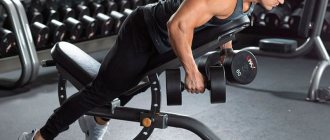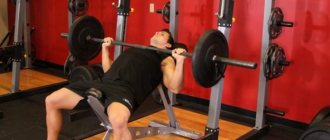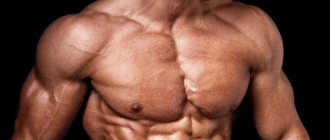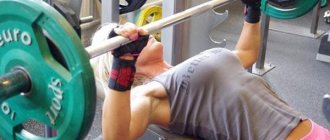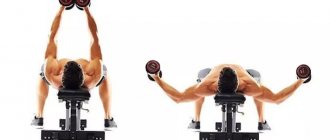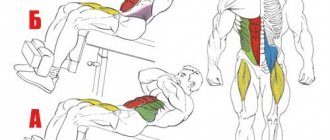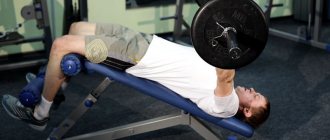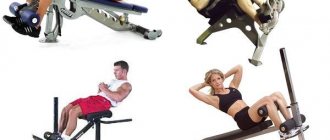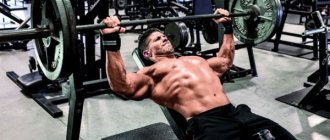Dumbbell flyes are an excellent exercise for building symmetrical, volumetric chest muscles. However, this exercise is aimed at working the entire area, namely the upper, middle and lower parts of the chest muscles. Incline dumbbell flyes are aimed at accentuating the work of the upper pectoral muscles. This option is very popular and is also relevant for those whose upper part is a lagging area of the pectoralis major muscle. Bodybuilders rely on bench lifts to create superior, symmetrical chest muscles.
The benefits of dumbbell flyes on an incline bench
- During the exercise, the muscles simultaneously stretch and contract, which has a positive effect on their growth. As a result of this movement, the muscles are enriched with all the necessary elements for hypertrophy.
- The exercise returns the muscles to their normal physiological state after basic chest exercises.
- Angled dumbbell raises do not require the use of a lot of weight, and also do not have a negative effect on the spinal column.
- Allows you to work concentratedly on target muscles.
- Dumbbell flyes at an angle are considered one of the most effective exercises for the formation of aesthetic, defined and symmetrical muscles.
Description of the exercise
Dumbbell flyes are aimed at working the pectoralis major and minor muscles. In the negative phase, they can be stretched very well, which at a young age helps to expand the diaphragm (like the pullover exercise).
In addition, the front, middle deltoids and biceps (mainly the short head) act as synergists. The upper trapezius is also involved.
The serratus abdominal muscles help maintain the position.
Different slope options allow you to shift and increase the load on certain areas
What muscles work
- The main muscles that are involved in the work are the pectoralis major muscles. The emphasis on the upper chest is achieved by tilting the torso.
- Part of the load is taken by the anterior delta bundles, as well as the serratus anterior muscles.
- The abdominal muscles, biceps and triceps receive static load
Common technical mistakes
Incline dumbbell flyes are an exercise of medium difficulty.
Although outwardly it seems easy (which is why it is popular among gym goers), very often beginners do it completely wrong, not understanding the essence of the movement.
The result is a formal execution that does not give the expected training effect.
Among the typical mistakes:
- Bend your elbows as you move and engage your triceps
When the arms are strongly bent, the dumbbells are lifted using the triceps. The result is something between a fly and a dumbbell bench press.
Correct technique involves slightly bending your elbows in the starting position and maintaining this position unchanged throughout the entire exercise.
The movement occurs in only one joint, as expected in an isolation exercise. In this case - in the shoulder.
The dumbbells describe a large arc when lowering down and return back along it.
- Amplitude too large
In an effort to better stretch the pectoral muscles, the dumbbells are often lowered as low as possible. This mistake can cost the health of your shoulder joints or pectoral ligaments.
If you lower the dumbbells below shoulder level, the pectoral ligaments do all the work of lifting the weight up. Overexertion often leads to injury, especially when working with heavy weights.
- Bringing your elbows forward
Another potentially traumatic mistake.
When lowering the dumbbells down, the elbows can lean forward, thereby overloading the elbow and shoulder joints. Regular exercise of this type eventually ends in injury.
When performed correctly, the shoulder, elbow and hand are on the same line. In this case, the elbows are directed towards the floor, not forward.
- Using excessively heavy dumbbells
Large weights negatively affect movement technique. This often forces additional muscles to work, removing the load from the target groups, and can also result in injury.
Incline dumbbell fly technique
Lifting dumbbells while lying at an angle of 30 or 45 degrees is technically no different from the classic version using a horizontal position.
- The starting position is as follows: lie on an inclined bench so that your head is higher than your shoulders. The arms should be extended upward, the elbows almost straight, but they should not be completely straightened, as this can lead to injury to the joints due to the increased load on them.
- Throughout the entire movement, your elbows should be turned to the sides.
- The movement is carried out in an arc strictly in the vertical direction.
- Please note that the exercise is carried out by tensing the pectoral muscles, and not the arm muscles.
- During the downward movement, the athlete must inhale.
- The lowest point of the amplitude is at the level of the pectoral muscles.
- Exhale while moving upward while bringing your arms together.
Execution technique
Even though this exercise looks quite simple, the technique should be taken as seriously as possible. This approach will protect you from injury and make your training as effective as possible.
Breeding on a horizontal bench
Let's first consider raising arms with dumbbells on a horizontal bench (another name is flattening dumbbells while lying down).
If the bench is inclined, level it horizontally with the floor. Prepare the necessary dumbbells in advance, immediately take the warm-up weight and the working weight. Let them stand near the bench on the floor. During one of the breaks, you can return the warm-up weights back to the dumbbell rack.
- Take dumbbells in your hands and sit on the edge of a bench.
- Lie down on a bench so that your head does not hang over it. The back of your head should touch the bench. It is best to place your own personal towel under your head and back. Spread your feet wide to ensure good stability. The benches touch the shoulder blades, back, pelvis, and back of the head. The lower back is in a natural position, without excessive deflections or roundings, the chest is straightened, looking at the ceiling.
- Raise the dumbbells in front of you at an angle of 90 degrees to the floor. The hands are turned out so that the palms are facing each other (this is a classic option). Bend them slightly at the elbow and freeze them in this position - you need to ensure that the angle of bending of the elbows does not change during the exercise.
- As you inhale, begin to spread the dumbbells to the sides so that your elbows point down. If your elbows turn out in any other way, you are doing the exercise incorrectly. Movement occurs only in the shoulder joint, a small angle at the elbow is fixed.
- When you feel that your chest muscles are already starting to stretch, lower your arms a little further, but, of course, not to the point of pain.
- As you exhale, bring your arms back together, almost touching the dumbbells to each other. You should feel something like you are hugging a large tree.
Repeat the exercise the required number of times. Then sit down, place the dumbbells at the edge of the bench on the floor and rest for 45-60 seconds. It is advisable to walk, do swings and shake your arms during the break between approaches. This will improve blood circulation in the muscles.
Breeding at an angle
If you want to make an angled layout, the technique will be exactly the same. The main thing is to remember that your elbows should be oriented towards the floor, and the movement should be straight up. We feel weights due to gravity, and its vector is always directed straight down. Therefore, if, when performing the fly at an angle, your elbows are not pointing down, there will be no benefit from the exercise.
Butterfly or fly in the simulator
You can perform fly-ups while sitting in a special machine - this exercise is called a butterfly. This is an isolated version of the breeding, with its help you can put a good load on the middle part of the pectoral muscle. It is very convenient because you don’t need to take dumbbells, you don’t need to walk and change them if the weights don’t suit you. It is enough to simply change the load directly in the simulator - quickly and conveniently.
Another plus is that in the simulator the exercise is almost always performed using the correct technique, since it is very difficult to do it incorrectly. Butterfly is a simple and pleasant option for working on the chest. But its effectiveness, unfortunately, is somewhat lower in comparison with dumbbells. In addition, this is an imitation of the horizontal version. Dumbbell flyes lying on an incline bench are not simulated in the butterfly machine.
Implementation recommendations
This exercise is best performed after basic exercises, such as barbell bench presses and incline bench presses, but can also be performed at the end of a workout.
Most often, a traditional training scheme is used, which consists of 3-4 sets of 8 to 12 repetitions, however, in some cases the number of repetitions can be increased to 15, for example, when working on endurance and relief.
You can also perform wiring at the beginning of the workout. In principle, this can be justified, since it allows you to very effectively and efficiently prepare the target muscles for work and pre-tire them if necessary.
For women, dumbbell flyes are suitable as a separate and only exercise for the chest or in combination (superset) with other chest exercises, for example, the dumbbell bench press. The best regimen for women is to perform no more than three sets of 15-25 repetitions each.
Be sure to do a warm-up set before using weights. As mentioned earlier, heavy working weight is absolutely unacceptable for this exercise . If the muscle work is not felt during the fly, you should increase the number of repetitions or replace it with a similar exercise, for example, bringing your arms together in a crossover.
Advantages and disadvantages
The exercise is very popular for chest training among bodybuilders. Almost no complex for these muscles is complete without dumbbell flyes.
Such love for the exercise should indicate the high effectiveness of the lifts.
Among the advantages of incline breeding are:
- Suitable for accentuating the upper chest
- Helps stretch the pectoral muscles and give them a more aesthetic shape
When training the chest only with pressing exercises, the muscle gradually shortens and contracts, and this negatively affects the aesthetics of the body.
To prevent this situation, after basic pressing exercises in bodybuilding it is customary to do muscle stretching exercises.
The best movements in this format are considered dumbbell flyes or pullovers while lying on a bench.
- Helps improve neuromuscular connections and intermuscular coordination
Since the weight is held separately in each hand, this creates additional stress on the muscles and the prerequisites for their accelerated growth.
But like most exercises, dumbbell flyes have their drawbacks.
Among the disadvantages:
- May be potentially hazardous. Especially if performed with heavy weights.
- Weakly increases muscle volume compared to basic chest exercises
- Not intended for developing chest muscle strength
- Technical difficulty for beginners
Despite the apparent ease, breeding has some nuances that are not so easy for a novice athlete to perform.
Bent-over dumbbell raises: what, why and why?
Quite popular, but at the same time one of the most “wrong” exercises. And all because a combination of factors is superimposed at once, which skews the technique, forcing the athlete to work with non-target muscles. Indeed, go to any gym, and you will see how each person performs dumbbell raises in his own way. In this note we will learn how to perform it in my opinion, as it is implied by the kinesiology of movement, i.e. the only possible option. Let's start, as usual, with the theoretical foundations, namely, with the muscle atlas.
Note: For better assimilation of the material, all further narration will be divided into subchapters.
According to statistics, the posterior deltoid muscle is the lagging part (head) of the three shoulders, which is not surprising, because the anterior deltoid is involved in most movements - chest press, dumbbell press, etc. Bent-over dumbbell raises are designed to “hook” and tighten this lagging part. This is a very important muscle (posterior fascicle) in terms of balanced development of the deltoids, which makes a significant contribution to the development of the posterior and lateral muscles.
The muscle mass involved in this isolation exercise looks like this:
- the main target is the rear and middle delta bundles;
- synergists – infraspinatus, teres minor, trapezoid, rhomboid;
- stabilizers - triceps, wrist/spine extensors, hamstrings, gluteus maximus, adductor.
In the picture version, the muscle atlas when raising dumbbells in an inclined position looks like this:
We recommend reading: How much should you eat to gain weight, the required number of calories
Advantages
By performing dumbbell raises on your shoulders, you get the following benefits:
- balanced and harmonious development of all delta heads;
- more rounded shoulder shape;
- strengthening the upper back;
- strengthening the rotator cuff (the most vulnerable and traumatic area of the shoulders);
- preventing frequent deltoid injuries;
- development of greater total effort in exercises such as bench press, head press.
Agree, there are quite a lot of benefits from such an isolation exercise.
Sequence of the exercise
1. Choose your warm-up and working weight. 2. Take warm-up dumbbells in your hands and sit on a bench. 3. Lower your back so that your head does not go beyond the edge of the bench. 4. Use a classic dumbbell grip: place your palms facing each other. 5. Raise the weights above your head, perpendicular to the floor. 6. Hands should be clearly positioned above the shoulder joints. 7. Raise your elbows until you feel maximum tension in your chest muscles. 8. As you exhale, return to the starting position. 9. Perform the exercise slowly and smoothly, watching your breathing.
Dumbbell flyes or dumbbell presses - which is better?
The bench press and the fly are two completely different movements, the use of which solves different goals and problems.
The dumbbell bench press is an exercise for increasing muscle mass and strength of the pectoral muscles. Dumbbell flyes are used to work out the muscles in more detail and give the chest a harmonious, complete look.
In practice, these exercises do not conflict with each other at all. On the contrary, they complement each other.
After a serious power load, it’s good to “finish off” and stretch the pecs using isolating dumbbell raises.
Advantages
Breeding dumbbells has undeservedly lost its popularity, especially among novice athletes. Many people try to replace this simple exercise with work in machines or bench press with dumbbells or a barbell. But breeding has many advantages:
- several muscles work at once: pectorals, deltoids, triceps;
- simple technique and minimum equipment;
- easy to perform without assistance;
- helps to form correct posture;
- muscles grow quickly;
- more effective than push-ups and pull-ups according to some researchers;
- allows you to choose an individual training regimen for any purpose.
If you want to learn how to enlarge your breasts quickly and easily, then take a closer look at dumbbell flyes!
How to tell if there's too much
Athletes often wonder how to determine weight overload. If after 10 repetitions in a set you feel very tired and even pain, then you need to lose 15-20% of the selected weight.
The next workout should begin with comfortable values. And vice versa, if you don’t feel anything after 10 times, then you should add a little, but within 10-15% of the indicator. Then hold this weight for 1-2 workouts, and you can increase further.
Work on mistakes
Many professional athletes recommend that beginners work with heavy weights at the expense of repetitions to increase strength and gain better muscle mass. However, judging by numerous reviews in the media, such recommendations do not apply to wiring. For this exercise, the priority is low weight and high repetitions. After all, as noted earlier, lifting dumbbells while lying on a bench is a very traumatic exercise.
In the last two sets, those who want to stretch their tight pectoral muscles can perform a stretch. To do this, you need to take a light weight (basically 50% of the worker) and perform the flyout with the elbows down as much as possible. Naturally, the exercise is performed with slightly bent elbows. If the spine bends during the exercise with the chest protruding forward, this should not be prevented.
Fans of forced exercises and drop sets cannot do without a partner. The partner must not only quickly change dumbbells, but also ensure the execution of the exercise. To do this, he must squat down at the head of the bench and support the athlete’s arms by the elbows with a full grip of the hand.
Execution options
To diversify your workout, you can add other methods of execution. Let's start with the variable grip. At the beginning of the lift, place your hands with a neutral grip, and at the top point, turn your palms towards your feet.
When raising, move your arms parallel to each other again. Such changes in position will transfer the load completely to the chest and eliminate the problem of getting used to the load.
You can also try the reverse move: raise and spread your arms with your palms down, and at the top point take a neutral, parallel position.
On an incline bench
The incline of the bench greatly influences which muscles are worked more. When you exercise on a bench, all the pectoral, anterior deltoid and triceps muscles are evenly included in the training. The horizontal surface is ideal for beginner athletes.
Positive angle
If you change the angle to positive, that is, raise your head above your legs, then the upper chest receives more load. Remember, the greater the angle of inclination, the more the deltas and upper fascicles of the pectoralis major are activated. Working at a positive 45-degree angle moves the center of tension closer to the middle of the chest.
Negative angle
If you lower the head end of the bench below the foot end, you will get a workout with a negative angle. In this position, the emphasis is on the lower part of the pectoral muscles. But you should be careful, because you may feel dizzy from unaccustomed use.
An exercise with a negative angle should be done after considerable training experience in the absence of problems with the vestibular apparatus and under the supervision of a trainer or partner.
The technique for performing the fly is identical in all variants: breathing, attention to the position of the hands, bringing together and fixing the shoulder blades - everything needs to be remembered at any angle of the bench. The positive angle is suitable for beginner athletes, and the negative angle can be done by well-trained people without health problems.
Separately about the shoulder blades
Let’s dwell a little on such a nuance as the position of the shoulder blades and the back in general in extension. This is rarely mentioned when describing technique, but it is the back that “dictates” to us the work of the whole body. During extension, the shoulder blades should be pressed against the bench as much as possible and strive to “straighten.”
This will allow you to form beautiful posture. You should not slouch or try to round your back, especially when getting up.
The feeling of straightened shoulders and a taut back with a slight arch should be maintained throughout the entire workout.
On the floor
Separately, you can try practicing on the floor. In this case, your arms should be lowered until they touch the floor, and your legs should be bent at the knees.
When not to exercise
As with any exercise, there are some contraindications to dumbbell flyes:
- condition after injuries, surgical interventions;
- exacerbation of any somatic pathology: increased blood pressure, exacerbation of asthma, gastritis, and so on;
- pregnancy in the second and third trimester and the first 2 months after childbirth, 4-5 after cesarean section;
- in case of pronounced anatomical changes in the spine: multiple hernias, protrusions, displacements;
- neurological disorders associated with the occurrence of tremor or partial loss of muscle control (epilepsy and epileptoid seizures, degenerative diseases, etc.);
- hernias in the abdominal cavity, diaphragm or anterior abdominal wall;
- severe flatulence, accumulation of fluid in the abdominal cavity, exacerbation of hemorrhoids.
Hold off on training if you suspect any of these conditions and consult a doctor. All subsequent classes must be supervised by a specialist.
Incorrect execution
The following mistakes are often encountered in the dumbbell fly technique:
- rounded and stooped back, lack of deflection;
- excessive arching in the lower back;
- raising your arms below shoulder level;
- sudden movements;
- hitting dumbbells at the top point;
- “help” with the muscles of the abs, legs - inertia turns on;
- moving the body along the bench during movements;
- completely straight arms, no “softening” in the elbows;
- different grip on the hands, change of grip during lifting or extension;
- pause below;
- lack of relationship between movement and breathing;
- tension in the cervical spine;
- lifting the feet off the floor while moving.
Violation of technique entails not only a decrease in training effectiveness, but also the risk of injury. It is especially dangerous to change the position of your arms and back while moving. These structures experience a large load that must be distributed correctly.
Lying dumbbell flyes video exercise
Brief conclusions
Lying dumbbell raises are an isolating load aimed at pumping the thoracic segment. Various variations of technique and bench inclination allow you to evenly load all muscle bundles. Wiring is performed after all bases. The main emphasis is not on weight, but on the number and frequency of repetitions. In order for dumbbell raises to be as effective as possible, you need to monitor the position of your elbows and not perform the load with straight arms.
Author: ForceMan from 02/23/2018, 18:17
- 0
What to replace
In terms of the structure of the movement, the chest exerciser “Pek Dec” (“Butterfly”) is close to the lying dumbbell fly.
A similar movement is also performed in a crossover. To do this, the bench is placed in the middle of the two lower blocks, and the lower handles of the machine are used instead of dumbbells.
In its essence, the classic version of bringing the hands together in a crossover (standing with the upper handles) is also close to the exercise.
A good alternative to the fly is a pullover with dumbbells or a barbell while lying down, or in a special machine.

